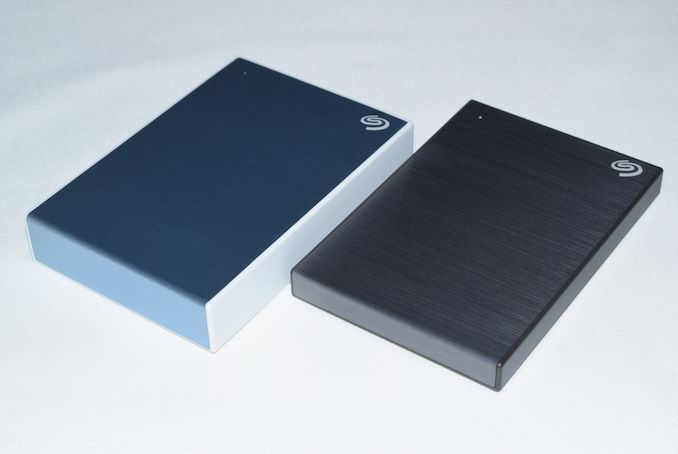Seagate Backup Plus Portable 5TB & Backup Plus Slim 2TB Review: SMR for the Consumer Market
by Ganesh T S on June 18, 2019 8:00 AM ESTMiscellaneous Aspects and Concluding Remarks
Performance numbers are not the only metric of interest for the target market. Value additions and other factors play a role too. We have already discussed about the value additions in the first page of this review. In this final section, we first take a look at the thermal performance and power consumption numbers.
Thermals and Power Consumption
The thermal design of the enclosures for HDD-based DAS devices is important because hard drives can't withstand as high a temperature range as flash-based devices. Higher temperatures tend to lower the reliability of the drives. In order to identify the effectiveness with which the enclosure can take away heat from the internal drive, we instrumented our robocopy DAS benchmark suite to record various parameters while the robocopy process took place in the background. Internal temperatures can only be gathered for enclosures that support S.M.A.R.T passthrough. Readers can click on the graphs below to view the full-sized version. The Backup Plus drives have similar thermal profiles - at the end of our sustained writes test (robocopy benchmark), the drive temperatures were only 48C and 49C respectively. The enclosures are made of plastic and do not get unduly hot.
| Storage Enclosure Thermal Characteristics | ||
 |
 |
|
Power consumption is measured while processing the same workload on each of the DAS units. CrystalDiskMark 5.1.2's benchmark traces with a region size of 8GB and the number of repetitions set to 5 are used. For bus-powered devices like the Seagate Backup Plus we are considering today, Plugable's USBC-TKEY power delivery sniffer was placed between the host PC and the storage bridge to record the power consumption. The pictures below present the numbers in a compact and easy to compare manner.
| Power Consumption - CrystalDiskMark | ||
 |
 |
|
Peak power consumption for the 5TB drive was around 4.2W, while the 2TB drive came in at 3.9W. Corresponding idle numbers are 1.4W and 1.1W.
Final Words
The performance profile of the Seagate Backup Plus Portable and Slim drives are as advertised. Which may not seem like high praise, but it's actually a feather in Seagate's cap: the company has been able to tune the firmware of the drives to largely hide the detrimental effects of SMR. It's not perfect, and prolonged use shows more performance degradation compared to traditional CMR drives. But the vast majority of the users are unlikely to notice anything causing significant issues.
On the pricing front, the 5TB drive is available for $95 - $130 (depending on the color), while the 2TB Slim is $55 - $80 (again, color-dependent). The 4TB WD My Passport comes between $100 and $115. On a per-TB basis, the 5TB Backup Plus Portable is quite cost-effective.
We would have liked both Seagate Backup Plus drive models to move to a Type-C interface or bundle a Type-C adapter, but those are minor quibbles in the whole scheme of things. The drives offer a unique value proposition in the bus-powered external hard drives market, particularly when the value additions are taken into account. As portable backup drives and for usage in write-once / read-many scenarios, the Seagate Backup Plus Portable and Slim drives are perfect fits. As long as the users are aware of the potential pitfalls / effects of SMR for their use-cases in the long run, the drives are definitely worth consideration.











62 Comments
View All Comments
StevoLincolnite - Tuesday, June 18, 2019 - link
Pass... It's a Seagate.Would be nice to get more mechanical disk benchmarks happening though, especially some of the larger 8-10TB+ drives.
MrSpadge - Tuesday, June 18, 2019 - link
Yeah, I've also seen at least one Seagate drive die. Never ever should anyone buy them again!29a - Tuesday, June 18, 2019 - link
If you're in it long enough you'll see all brands die.Death666Angel - Tuesday, June 18, 2019 - link
I think MS was being sarcastic by indulging in SLs nonsense comment.StevoLincolnite - Tuesday, June 18, 2019 - link
Not a nonsense comment.Nor did I mention anything about reliability... That was just an assumption by MrSpadge.
Oliseo - Sunday, June 23, 2019 - link
Here's the thing, the English language is such that you don't have to literally mention reliability for everyone to know that's exactly what you were talking about.Or are you now claiming everyone else was wrong to infer what you implied? In which case, the onus is on you to be more explicit in future to what you're actually talking about.
StevoLincolnite - Monday, June 24, 2019 - link
Rubbish Oliseo.Then again, if people automatically assumed I was talking about the drives reliability, maybe that just says everything about Seagates track record?
I was actually talking about warranty, or lack there-of here... I don't want to have to send anything overseas for replacement/repair.
eek2121 - Tuesday, June 18, 2019 - link
I have some hard drives that would like to disagree with you. Including a 10 MB one. MB. Not GB.Henry 3 Dogg - Sunday, January 30, 2022 - link
unless you made it yourself, I've seen a drive of that brand dieeek2121 - Tuesday, June 18, 2019 - link
I had the 5 GB drive die after 3 months of use. No more seagate for me. Loved the form factor though. These drives are small.